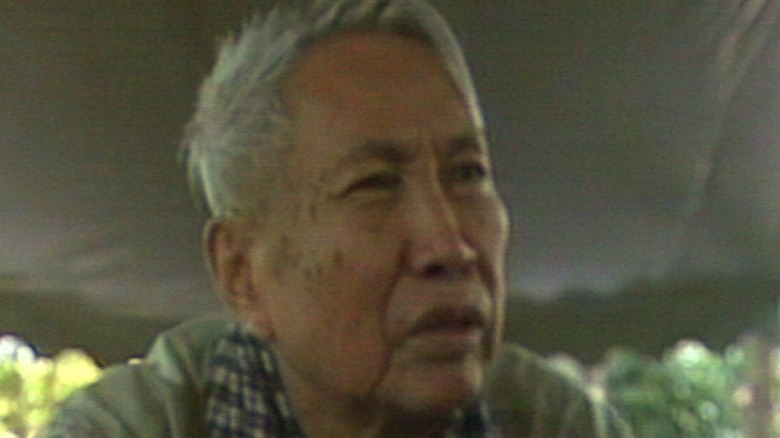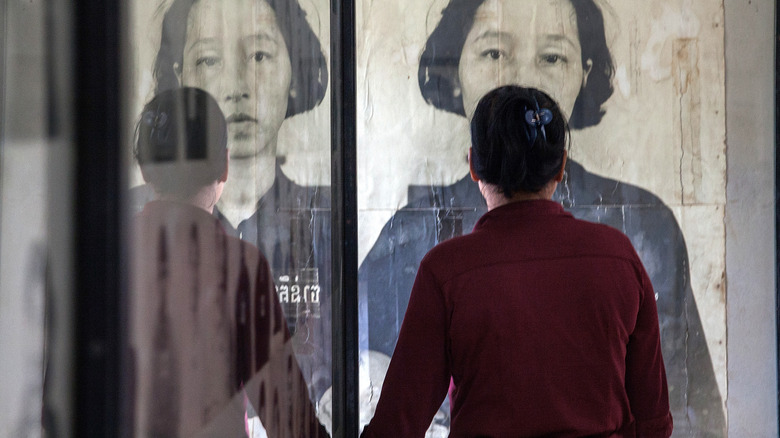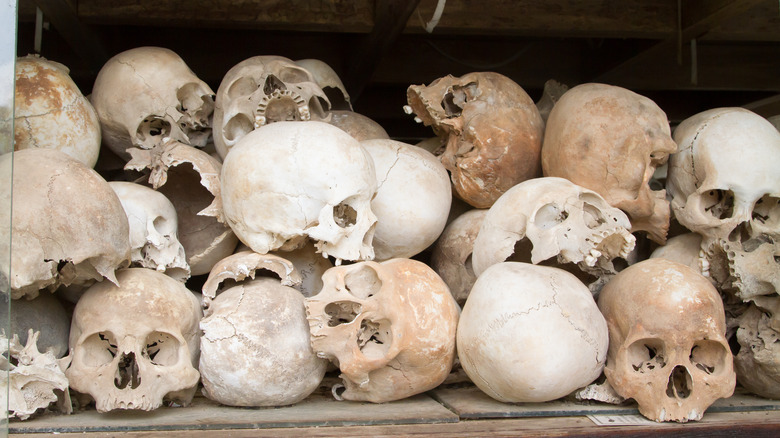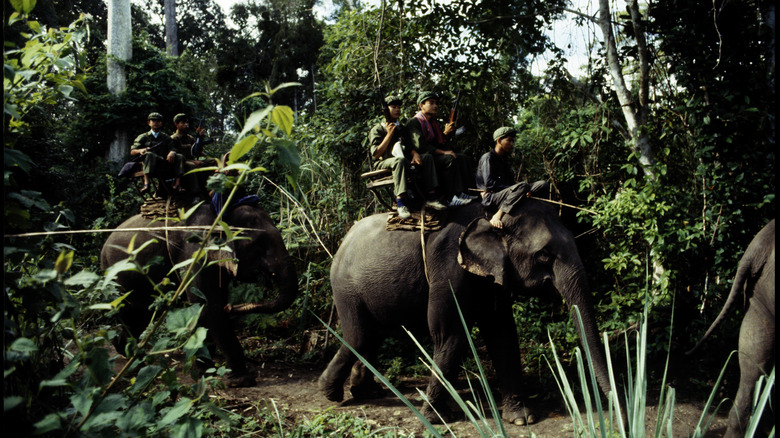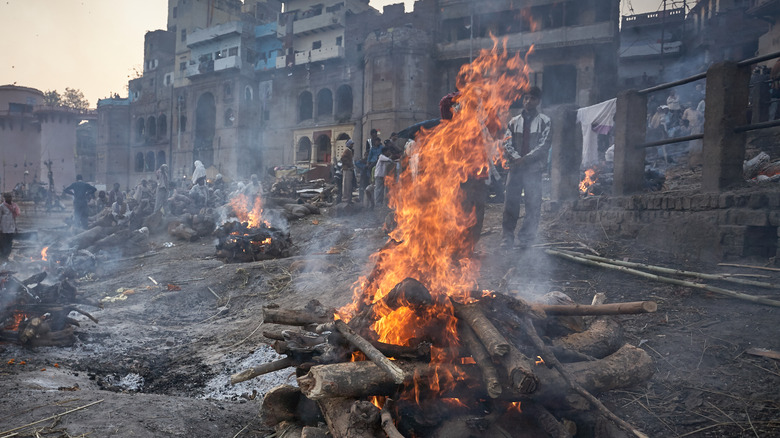The Truth About Pol Pot's Corpse
The last century has borne witness to countless wars and acts of government brutality in Asia. The Nanking Massacre committed by the Japanese during World War II and the oppressive regime of North Korea are horrific bookends to the last 80 years in that part of the globe. While cold-blooded dictators and ruthless military leaders have shed blood all over the globe for millennia, some of the most monstrous have made their bloody marks within recent memory. One of the most savage examples of this ruthlessness was Pol Pot, the one-time ruler of Cambodia.
While lesser known than other 20th century tyrants like Hitler or Stalin, Pol Pot's genocidal legacy places him on the same vile level of derangement and nefariousness. The terror Pol Pot subjected his own people to in just a few short years will forever cement him in history as one of the worst national leaders.
Emergence of the Khmer Rouge
A man with humble beginnings, Pol Pot (or Saloth Sar at birth), was born in 1925 to farming parents north of the Cambodian capital of Phnom Pehn (via History). Moving to the capital in 1934, he spent a year in a Buddhist monastery before being placed in a French Catholic school. After graduation, Pol Pot moved to Paris to continue his formal education in 1949. It was here that he began studying Communism.
When he returned to Cambodia several years later, his country was in turmoil. Having been occupied by France since the French colonization began in 1887 (via Thought Company), the Cambodians were growing weary of their influence. Rebellions against French occupation were beginning to erupt in Cambodia in the mid-1950s. Joining up with the Khmer People's Revolutionary Party (KPRP), Pol Pot was able to unite his Communist ideals with an active, pro-Communist group.
While the Communist espousing Pol Pot didn't immediately take over control of Cambodia, the groundwork was laid for future Communist rule. After a lengthy Cambodian civil war, the KPRP (now known as the Khmer Rouge) was able to overtake the capital of Phnom Pehn (via History).
After he was installed as the leader of the new government, Pol Pot set his sights on the agrarian Cambodians who lived in the north. He felt that collective farming was the solution to his country's woes and that he would be able to turn Cambodia into an agriculture-based utopia. His new subjects were soon to find out that this would be the beginning of a national nightmare.
The genocide begins
In order to accomplish his dream of an agricultural utopia, Pol Pot first abolished all currency (via History). He then took away private property ownership, banned religion outright, and then began the forced migration of citizens from the cities to the countryside.
Thus began the collective farming. Not able to sustain the new population, the rural areas began to suffer from famine (via Britannica). Long hours and harsh working conditions broke the bodies and the spirits of the workers, most of whom had never done any farm labor. This led to hundreds of thousands of Cambodians dying from starvation, work injuries, and diseases that swept through the fields.
Pol Pot felt threatened by the educated class, so he began to have them tortured and executed. All told, more than two million Cambodians died from execution, disease, or starvation under Pol Pot's rule. Their bodies were buried in mass graves, known forever as "the killing fields." (via Culture Trip). It's been reported that there were over 20,000 mass graves for suffering Cambodians. Thankfully for the surviving Cambodians, the nightmare dictatorship of Pol Pot was short-lived, and by 1979 their rescuers were beginning to flood across the border.
Vietnamese invasion and splinter groups
In early 1979, the Vietnamese military invaded Cambodia in an attempt to oust Pol Pot. This ten-year invasion and occupation took the lives of an estimated 30,000 Vietnamese troops (via BBC). Not being prepared for a full-scale war with anyone, the Khmer Rouge was quickly removed from power within weeks of the initial invasion, forcing Pol Pot and his forces to retreat to the jungles. The major battle was over, but skirmishes between the Vietnamese army and Pol Pot's troops would continue for nearly a decade.
After the fall of the Khmer Rouge, the ousted Prince Norodom Sihanouk was returned to power for the first time since Pol Pot seized the capital city in 1975 (via History). Pol Pot continued to plot in rural areas until a splinter group of the Khmer Rouge placed him under arrest in 1997. What happened next is still the subject of international debate.
Pol Pot's house arrest and death
After a trial that was regarded as a "show," Pol Pot was placed under indefinite house arrest for his crimes against the Cambodian people (via History). But his house arrest didn't last long. On April 15th, 1998, Pol Pot was reported dead from an apparent heart attack (via Southeast Asia Globe). But rumors began to immediately circulate that his death wasn't from heart failure. Fear that his one-time allies were going to turn him over to the United States may have prompted him to do himself in. One Khmer Rouge senior official stated that the ousted dictator took a cocktail of medication in hopes of a deliberate overdose (via BBC). The United States government denies that they were trying to apprehend Pol Pot.
The body of Pol Pot was placed on public display for days, to show the world that one of their worst monsters was now dead. Following his period of lying in state, Pol Pot's body was thrown on a fire and cremated.
